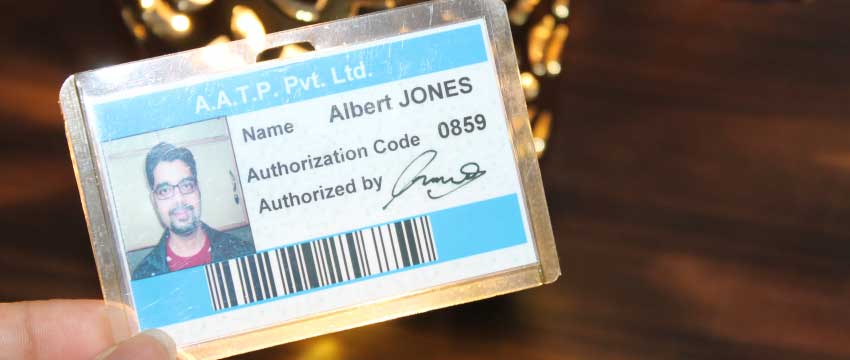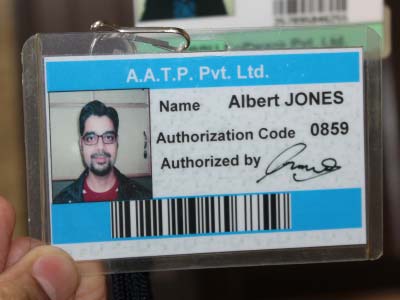Visitor ID Cards Can be Used for Tracking Visitor Activity
Here's how visitor ID cards can be used for tracking visitor activity:
🟆 Identification: Visitor ID cards serve as a form of identification, allowing security personnel or staff members to verify the identity of individuals within a premises. The cards can display the visitor's name, photo, and other relevant information, making it easier to distinguish between authorized visitors and unauthorized individuals.
🟆 Access Control: ID cards can be equipped with technologies like RFID (Radio-Frequency Identification) or barcode scanners, which enable access control systems to track when and where visitors enter or exit specific areas. These systems are often integrated with electronic door locks or turnstiles, ensuring that only authorized individuals can access restricted areas. By logging each entry and exit, a record of the visitor's movement can be created.
🟆 Time Tracking: Visitor ID cards can incorporate time-tracking features, such as timestamping each entry and exit. This allows organizations to monitor the duration of a visitor's stay and determine if they have overstayed their authorized time or if they have left the premises within the allocated timeframe.
🟆 Visitor Management Systems: Many organizations use visitor management systems, which are software applications designed to streamline the check-in/check-out process and track visitor activity. These systems often work in conjunction with ID cards, capturing relevant data such as check-in time, purpose of visit, and destination. They can generate detailed reports on visitor statistics, including the number of visits, peak times, and average visit duration.
🟆 Emergency Situations: In the event of an emergency, visitor ID cards can assist in accounting for all individuals present within a premises. By cross-referencing the visitor records with real-time information, security personnel can quickly determine who might be in danger or still inside the building, enabling them to prioritize rescue efforts.
🟆 Analyzing Patterns: By analyzing the data collected from visitor ID cards, organizations can gain insights into visitor patterns and behaviors. For example, they can identify popular areas or exhibits within a museum, peak visiting hours, or visitor preferences based on historical data. This information can be used to optimize resources, improve security measures, and enhance the overall visitor experience.
It's important to note that the use of visitor ID cards for tracking visitor activity raises privacy concerns. Organizations should ensure that they handle visitor data responsibly, adhere to relevant data protection regulations, and clearly communicate their data collection practices to visitors. Transparency, consent, and secure data storage are essential aspects to consider when implementing such tracking systems.
Cost of Creating Visitor ID Cards
Creating visitor ID cards can involve various factors that contribute to the overall cost such as:-

-
Design and Layout:
The design and layout of visitor ID cards can impact their cost. Customized designs, logos, graphics, or specific branding requirements might incur additional charges compared to standard designs. Factors such as complexity, colors, and printing techniques can affect the overall cost.
-
Variable Data Printing:
If the visitor ID cards need to contain unique information for each visitor, such as names, photos, or identification numbers, variable data printing is required. This process involves merging a database with the printing process and can add to the cost, especially for large quantities.
-
Card Size and Shape:
Standard ID card sizes are typically 3.375 x 2.125 inches (credit card size), but custom sizes and shapes might incur additional costs. Unconventional shapes or larger sizes may require specialized cutting or printing processes, leading to higher expenses.
-
Supplier and Location:
The choice of supplier and their location can influence the cost of creating visitor ID cards. Local suppliers may have higher labor as well as material costs, while overseas suppliers might have lower production costs but higher shipping expenses as compared to local suppliers.
-
Security Features:
Visitor ID cards may require security features to prevent counterfeiting or unauthorized duplication. These features can include holograms, UV ink, barcodes, magnetic stripes, or embedded RFID (Radio Frequency Identification) chips. The inclusion of such advanced security features will increase the overall cost.
-
Card Material:
Visitor ID cards can be made from different materials, including PVC (Polyvinyl Chloride) or plastic, paper, or even smart cards with embedded technology. The material chosen affects the durability and cost of the cards. PVC or plastic cards are commonly used due to their durability and resistance to wear and tear.
-
Quantity:
The number of visitor ID cards needed can significantly affect the cost. Printing in bulk typically reduces the per-unit cost, while smaller quantities may be subject to higher costs due to setup and printing overheads.
-
Accessories and Attachments:
Additional costs may arise if accessories or attachments are required, such as lanyards, badge holders, clips, or retractable reels. These items can vary in quality and customization, impacting the overall cost.
-
Turnaround Time:
Urgent orders or tight deadlines may incur rush fees or expedited shipping charges to ensure timely delivery. If time is of the essence, the cost may increase.
-
Printing
Techniques:
The printing techniques used can impact the cost. Common techniques include digital printing, offset printing, or thermal printing. Each method has its own advantages and costs. Digital printing is suitable for small quantities and intricate designs, while offset printing is cost-effective for larger quantities. Thermal printing is often used for simple text-based cards.
It is essential to consider these factors when estimating the cost of creating visitor ID cards. Prices will vary depending on specific requirements, customization, quantity, and the chosen supplier. To get an accurate cost estimate, it is recommended to reach out to printing companies or suppliers for quotations based on your specific needs.
Visitor ID cards can serve as effective tools for marketing and branding purposes, providing a range of benefits to organizations. Here are several ways in which visitor ID cards can be utilized for marketing and branding:
Brand Visibility and Recognition: Visitor ID cards present an opportunity to showcase your organization's brand identity. By incorporating your logo, brand colors, and other visual elements onto the ID card, you can increase brand visibility and reinforce brand recognition. This is particularly valuable when visitors interact with employees or move around your premises, as your brand will be consistently displayed.
Professional Image: Visitor ID cards contribute to creating a professional image for your organization. When visitors see employees wearing branded ID cards, it enhances their perception of your company's credibility, trustworthiness, and attention to detail. This professional image can positively impact visitors' overall experience and their perception of your brand.

Networking and Engagement: Visitor ID cards can facilitate networking and engagement opportunities. By including contact information, such as a name, job title, and email address, on the ID card, visitors can easily connect with employees they interact with. This promotes communication and fosters relationships that may lead to potential business opportunities or partnerships.
Personalized Messaging and Offers: Visitor ID cards can be used to provide personalized messaging or offers. If your organization hosts events or conferences, you can customize the ID cards with attendee names and agenda details, creating a personalized experience. Additionally, you can include QR codes or unique identifiers on the cards, which visitors can scan to access exclusive promotions, discounts, or digital content related to your brand.
Brand Consistency Across Locations: If your organization operates in multiple locations or has branches, visitor ID cards can help maintain brand consistency. By designing a standardized ID card template, you can ensure that all employees across different locations display a consistent brand image. This promotes a unified brand identity and strengthens brand recognition across your organization.
Word-of-Mouth Marketing: Visitor ID cards can act as conversation starters, prompting discussions about your organization. If your ID card design is eye-catching or incorporates unique branding elements, visitors may inquire or comment about it. This can initiate conversations about your company, products, or services, leading to positive word-of-mouth marketing and potential referrals.
Social Media Promotion: In the age of social media, visitor ID cards can play a role in promoting your brand online. Encouraging visitors to take photos of their ID cards and share them on social media platforms with branded hashtags or handles can generate user-generated content. This user-generated content serves as organic promotion and allows your brand to reach a wider audience.
Data Collection and Analysis: Visitor ID cards can facilitate data collection for marketing purposes. By utilizing technologies like barcodes or RFID chips on the cards, you can track visitor movements and behaviors within your premises. This data can provide valuable insights for targeted marketing campaigns, improving the effectiveness of your marketing strategies.
📝 In conclusion, visitor ID cards offer a range of marketing and branding opportunities. From enhancing brand visibility and recognition to facilitating networking, personalization, and social media promotion, ID cards can contribute to a professional image and strengthen your organization's brand identity. Leveraging the potential of visitor ID cards for marketing purposes can lead to increased brand awareness, customer engagement, and business growth.
Visitor ID Cards can be Integrated with Access Control Systems
Visitor ID cards can be integrated with access control systems to enhance security and streamline visitor management processes. Here's a detailed explanation of how visitor ID cards can be integrated with access control systems: